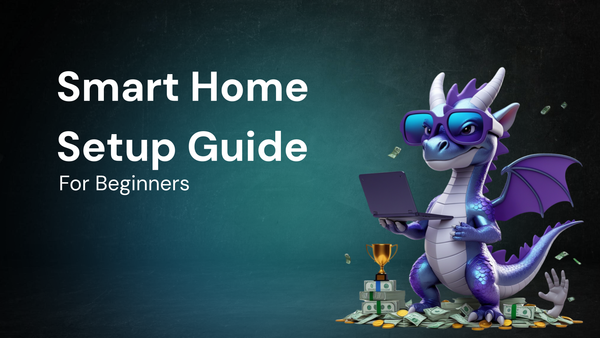Your Guide to Must-Have Tools for a Smart Home

Your Guide to Must-Have Tools for a Smart Home: Building the Connected Life
The allure of a smart home – a dwelling where technology seamlessly integrates to enhance comfort, security, and efficiency – is undeniable. Imagine controlling your lights with a voice command, adjusting your thermostat remotely, or receiving real-time alerts about potential security breaches. While the concept might seem futuristic, building a smart home is more accessible than ever, thanks to a wide array of readily available devices and tools.
However, navigating the smart home landscape can be overwhelming. With countless gadgets promising to revolutionize your life, it's crucial to understand the core components, the technologies they employ, and how they integrate to create a truly smart and connected environment. This guide will walk you through the must-have tools for building a smart home, covering everything from essential hubs and controllers to specialized devices for security, entertainment, and energy management.
I. The Foundation: Smart Home Hubs and Controllers
At the heart of any smart home lies a central hub or controller. This device acts as the brain, connecting and coordinating all your smart devices, allowing them to communicate with each other and with you. Choosing the right hub is crucial, as it determines the compatibility of your smart home ecosystem and the features you'll be able to access.
- Smart Speakers with Integrated Hubs (Amazon Echo, Google Nest Hub): These popular devices offer a convenient entry point into the smart home world. Equipped with voice assistants like Alexa or Google Assistant, they allow you to control compatible devices using simple voice commands. Many models also feature built-in Zigbee or Z-Wave radios, enabling direct communication with a wide range of smart home devices without the need for a separate hub.
- Pros: Easy to set up and use, voice control, integrated AI assistants, relatively affordable, wide range of compatible devices.
- Cons: Reliance on cloud services, potential privacy concerns, limited customization options compared to dedicated hubs.
- Dedicated Smart Home Hubs (Samsung SmartThings, Hubitat Elevation): These hubs offer more advanced control and customization options compared to smart speakers. They typically support a wider range of communication protocols, including Zigbee, Z-Wave, and Wi-Fi, ensuring compatibility with a broader selection of devices. They also often provide local processing capabilities, allowing some smart home automations to function even without an internet connection.
- Pros: Greater control and customization, support for multiple communication protocols, local processing, enhanced security features.
- Cons: More complex setup and configuration, higher cost compared to smart speakers, steeper learning curve.
- Apple HomePod Mini (with HomeKit): For users deeply invested in the Apple ecosystem, the HomePod Mini provides a seamless smart home experience. It integrates with Apple's HomeKit platform, allowing you to control compatible devices using Siri voice commands or the Home app on your iPhone, iPad, or Mac.
- Pros: Seamless integration with Apple devices, strong focus on privacy and security, easy setup for Apple users.
- Cons: Limited compatibility with non-HomeKit devices, reliance on the Apple ecosystem.
Choosing the Right Hub:
When selecting a smart home hub, consider the following factors:
- Compatibility: Ensure the hub supports the communication protocols used by your desired smart devices (Wi-Fi, Zigbee, Z-Wave, Bluetooth).
- Voice Assistant: Choose a hub that integrates with your preferred voice assistant (Alexa, Google Assistant, Siri).
- Features: Evaluate the hub's features, such as local processing, advanced automation capabilities, and security options.
- Ecosystem: Consider the ecosystem of the hub and the availability of compatible devices.
- Budget: Set a budget and compare the prices of different hubs and their associated devices.
II. Enhancing Security: Smart Locks, Cameras, and Sensors
Security is a primary concern for many homeowners, and smart home technology offers a powerful suite of tools to protect your property and loved ones.
- Smart Locks: Replace your traditional deadbolt with a smart lock to control access to your home remotely. You can lock and unlock your door using your smartphone, create temporary access codes for guests, and receive notifications whenever the door is opened or closed.
- Key Features: Remote control, keyless entry, temporary access codes, activity logs, auto-lock functionality.
- Popular Brands: August, Yale, Schlage, Kwikset.
- Smart Security Cameras: Monitor your home's interior and exterior with smart security cameras. These cameras typically offer features such as motion detection, night vision, two-way audio, and cloud storage for recorded footage.
- Key Features: Motion detection, night vision, two-way audio, cloud storage, live streaming, facial recognition (in some models).
- Popular Brands: Arlo, Ring, Nest, Wyze.
- Smart Doorbell Cameras: Identify visitors and communicate with them remotely using a smart doorbell camera. These doorbells feature a built-in camera, microphone, and speaker, allowing you to see and speak to anyone at your door, even when you're not home.
- Key Features: Motion detection, two-way audio, video recording, night vision, integration with smart home platforms.
- Popular Brands: Ring, Nest, Arlo, Eufy.
- Smart Sensors (Motion, Door/Window, Water Leak): Detect potential threats and alert you to emergencies with smart sensors. Motion sensors can detect unauthorized activity, door/window sensors can monitor entry points, and water leak sensors can detect leaks and prevent water damage.
- Key Features: Real-time alerts, integration with smart home platforms, customizable settings.
- Popular Brands: Samsung SmartThings, Aqara, Ring, Honeywell.
Choosing the Right Security Devices:
When selecting smart security devices, consider the following factors:
- Video Quality: For cameras and doorbells, prioritize devices with high-resolution video and a wide field of view.
- Night Vision: Ensure the device has effective night vision capabilities for clear visibility in low-light conditions.
- Motion Detection: Look for devices with adjustable motion detection sensitivity to minimize false alarms.
- Cloud Storage: Consider the cloud storage options offered by the device and the associated costs.
- Integration: Ensure the device integrates seamlessly with your smart home hub and other security devices.
- Power Source: Choose devices with battery power or wired power options based on your needs and installation capabilities.
III. Entertainment and Automation: Smart Lighting, Thermostats, and Entertainment Systems
Beyond security, smart home technology can significantly enhance your comfort and convenience, transforming your home into an entertainment hub and optimizing energy consumption.
- Smart Lighting: Control your lights remotely, create custom lighting scenes, and automate your lighting based on schedules or events with smart light bulbs, switches, and dimmers.
- Key Features: Remote control, dimming capabilities, color changing (in some bulbs), scheduling, voice control, integration with smart home platforms.
- Popular Brands: Philips Hue, LIFX, TP-Link Kasa, Sengled.
- Smart Thermostats: Optimize your home's temperature and save energy with a smart thermostat. These thermostats learn your heating and cooling preferences, automatically adjust the temperature based on your schedule, and allow you to control the temperature remotely.
- Key Features: Remote control, scheduling, learning capabilities, energy usage reports, geofencing (automatically adjusts the temperature based on your location).
- Popular Brands: Nest, Ecobee, Honeywell, Sensibo.
- Smart Entertainment Systems (Smart TVs, Streaming Devices, Smart Speakers): Transform your living room into a state-of-the-art entertainment center with smart TVs, streaming devices (like Roku, Apple TV, and Chromecast), and smart speakers. These devices offer access to a wide range of streaming services, voice control, and seamless integration with other smart home devices.
- Key Features: Access to streaming services, voice control, screen mirroring, integration with smart home platforms.
- Popular Brands: Samsung, LG, Sony (Smart TVs), Roku, Apple TV, Google Chromecast (Streaming Devices), Amazon Echo, Google Nest (Smart Speakers).
- Smart Blinds and Shades: Automate your window coverings to control natural light, privacy, and energy efficiency. Smart blinds and shades can be controlled remotely, scheduled to open and close at specific times, and integrated with other smart home devices.
- Key Features: Remote control, scheduling, automated light control, integration with smart home platforms.
- Popular Brands: Lutron, Somfy, Serena Shades.
Choosing the Right Entertainment and Automation Devices:
When selecting entertainment and automation devices, consider the following factors:
- Compatibility: Ensure the devices are compatible with your smart home hub and other smart devices.
- Features: Evaluate the features offered by each device and choose those that best meet your needs and preferences.
- Ease of Use: Opt for devices that are easy to set up, use, and manage.
- Reliability: Choose devices from reputable brands known for their quality and reliability.
- Price: Compare the prices of different devices and choose those that offer the best value for your money.
IV. Essential Tools for Installation and Maintenance
While many smart home devices are designed for easy installation, having the right tools on hand can make the process smoother and more efficient.
- Screwdrivers (Phillips Head and Flathead): Essential for installing smart lights, switches, and door locks.
- Wire Strippers/Cutters: Necessary for connecting wiring during the installation of smart switches and dimmers.
- Voltage Tester: Use a voltage tester to ensure that the power is off before working on electrical wiring.
- Drill and Drill Bits: Useful for mounting security cameras and installing smart blinds.
- Level: Ensure that your devices are installed straight and level.
- Network Analyzer App: Help troubleshoot network connectivity issues and optimize your Wi-Fi signal. (e.g., Wi-Fi Analyzer for Android, NetSpot for macOS)
- Cable Ties and Label Maker: Organize and label your cables for easy identification and maintenance.
- Multimeter: A versatile tool for troubleshooting electrical problems.
V. Best Practices for a Successful Smart Home Implementation
Building a smart home is an ongoing process, and following these best practices can help ensure a smooth and successful implementation:
- Start Small: Begin with a few essential devices and gradually expand your smart home ecosystem as you become more comfortable with the technology.
- Plan Your Network: Ensure you have a strong and reliable Wi-Fi network to support your smart devices. Consider using a mesh Wi-Fi system to extend coverage throughout your home.
- Prioritize Security: Implement strong passwords and enable two-factor authentication for all your smart home accounts.
- Keep Software Updated: Regularly update the firmware and software of your smart devices to ensure they have the latest security patches and features.
- Learn to Automate: Explore the automation capabilities of your smart home hub to create custom routines that simplify your life.
- Embrace Interoperability: Choose devices that support open standards like Zigbee and Z-Wave to ensure compatibility with a wider range of products.
- Regularly Review and Adjust: Periodically review your smart home setup and adjust your devices and automations to optimize performance and meet your changing needs.
VI. The Future of Smart Homes
The smart home landscape is constantly evolving, with new technologies and innovations emerging all the time. Expect to see further advancements in:
- Artificial Intelligence (AI): AI will play an increasingly important role in smart homes, enabling more personalized and proactive automation.
- Edge Computing: Moving processing power to the edge of the network (i.e., the devices themselves) will improve responsiveness and reduce reliance on cloud services.
- 5G Connectivity: Faster and more reliable 5G networks will enable more sophisticated smart home applications, such as enhanced security cameras and seamless streaming.
- Matter (Connectivity Standard): The new Matter standard promises to simplify smart home connectivity by creating a universal language for smart devices, making them more interoperable and easier to set up.
Conclusion
Building a smart home is an exciting journey that can transform your living space into a more comfortable, secure, and efficient environment. By understanding the core components, selecting the right tools, and following best practices, you can create a smart home that seamlessly integrates technology into your daily life. Embrace the connected life and enjoy the benefits of a truly smart home!




